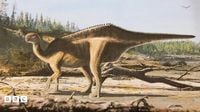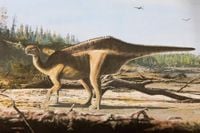On the windswept shores of England’s Isle of Wight, a new chapter in dinosaur history has just been written—one that brings together ancient bones, a legendary sailor, and the mystery of evolution’s flair for the dramatic. On August 22, 2025, paleontologists and science enthusiasts alike learned of the discovery of a striking new dinosaur species: Istiorachis macarthurae, a creature whose most eye-catching feature was a towering, sail-like structure running the length of its back and tail.
This remarkable find, as reported by CNN, BBC Newsround, IFLScience, and MSN, is the result of both fresh eyes and old bones. The fossils themselves were unearthed decades ago and had been quietly resting in the collection of the Isle of Wight’s Dinosaur Isle Museum. For years, they were thought to belong to one of the two known iguanodontian dinosaur species native to the island. But it took the curiosity and persistence of Jeremy Lockwood—a retired medical doctor turned PhD student at the University of Portsmouth and the Natural History Museum, London—to reveal their true nature.
Lockwood’s breakthrough came not from a dramatic dig, but from a careful reexamination of the fossilized bones. “While the skeleton wasn’t as complete as some of the others that have been found, no one had really taken a close look at these bones before,” Lockwood explained to BBC Newsround. What caught his attention were the dinosaur’s extraordinarily long neural spines—bony projections that, in life, would have formed a sail-like crest rising high above the animal’s back. “It was thought to be just another specimen of one of the existing species, but this one had particularly long neural spines, which was very unusual,” he told IFLScience.
The new species, classified as an iguanodontian—a group of herbivorous dinosaurs related to the famous Iguanodon—stood about two meters tall and likely weighed around one ton, according to Lockwood’s estimates. But it was the sail that made Istiorachis macarthurae truly stand out. The name itself is a nod to both its appearance and local heritage: “Istiorachis” means “sail spine,” and “macarthurae” honors Dame Ellen MacArthur, the celebrated sailor and Isle of Wight native who set the world record for the fastest solo non-stop voyage around the globe in 2005.
The connection between dinosaur and sailor is more than just a clever play on words. As BBC Newsround quipped, “Like the dino, Dame Ellen also comes from the Isle of Wight—just a few hundred million years later!” For MacArthur, having a dinosaur named in her honor is a unique addition to her already impressive list of achievements.
The origins of this sail-like feature trace back to the Berriasian stage of the Early Cretaceous, around 140 million years ago, with the fossil itself dating to roughly 125 million years ago. According to Editorji and MSN, the development of elongated neural spines among iguanodontians began in the Late Jurassic and became increasingly common during the Early Cretaceous period. Yet, as Professor Susannah Maidment of the Natural History Museum pointed out, “true hyper-elongation—where spines stretched more than four times the height of the vertebral body—is still very rare.”
So what purpose did this extravagant sail serve? Theories abound, but Lockwood and his colleagues believe the most likely explanation is visual signaling, specifically as part of a sexual display. “Evolution sometimes seems to favor the extravagant over the practical,” Lockwood observed in Papers in Palaeontology, the peer-reviewed journal where the findings were published. “While the exact purpose of such features has long been debated—with theories ranging from body heat regulation to fat storage—researchers believe that the most likely explanation in this case is visual signaling, possibly as part of a sexual display, and this usually is because of sexual selection.”
Lockwood elaborated, “In modern reptiles, sail structures often show up more prominently in males, suggesting that these attributes evolved to impress mates or intimidate rivals. We think Istiorachis may have been doing much the same.” The sail would have acted much like a peacock’s tail—an ostentatious trait favored by evolution not for survival, but for attracting a mate. “When a trait exaggerates its practical function in living animals, this is usually driven by evolutionary pressure to attract a partner. The sail of Istiorachis seems yet another example of this,” Lockwood told CNN.
The research team reached this conclusion by comparing the fossilized bones to a database of similar dinosaur backbones, allowing them to trace how these sail-like structures evolved over time. “We showed that Istiorachis’s spines weren’t just tall—they were more exaggerated than is usual in Iguanodon-like dinosaurs, which is exactly the kind of trait you’d expect to evolve through sexual selection,” Lockwood explained to MSN.
Professor Maidment underscored the broader significance of the discovery. “Jeremy’s careful study of fossils that have been in museum collections for several years has brought to life the iguandontian dinosaurs of the Isle of Wight. His work highlights the importance of collections like those at Dinosaur Isle, where fossil specimens are preserved in perpetuity and can be studied and revised in the light of new data and new ideas about evolution.” She added, “Over the past five years, Jeremy has single-handedly quadrupled the known diversity of the smaller iguanodontians on the Isle of Wight, and Istiorachis demonstrates we still have much to learn about Early Cretaceous ecosystems in the UK.”
This discovery is more than just another name on a long list of prehistoric creatures. It’s a reminder that even in well-trodden territory—both literally and scientifically—there are still surprises waiting to be uncovered. As Lockwood put it to CNN, “Discovery of yet another iguanodontian from the Isle of Wight indicates that this was a highly diverse place in the Early Cretaceous. I’m confident that even more discoveries await us in the coming years.”
With Istiorachis macarthurae, scientists gain not only a new piece of the puzzle in dinosaur evolution but also a vivid example of nature’s penchant for spectacle—whether on Jurassic plains or modern-day oceans. And for the Isle of Wight, it’s another claim to fame, uniting the ancient and the contemporary in one extraordinary sail.






